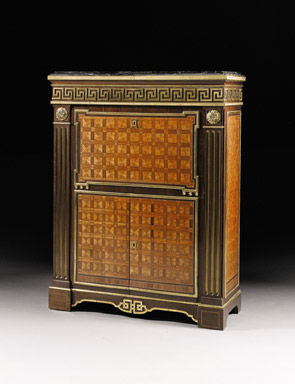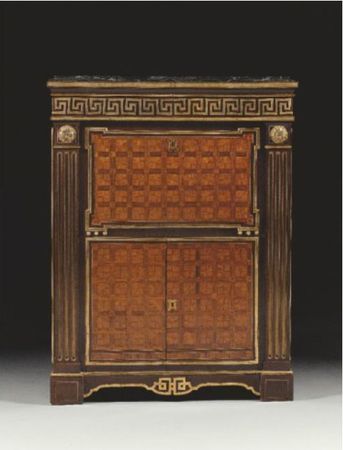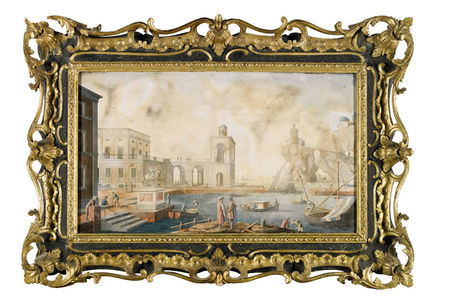Sotheby's to offer The Collection of Prince and Princess Henry de La Tour d'Auvergne Lauraguais
A gilt-bronze-mounted amaranth, tulipwood, bois satiné, parquetry and oak, Goût Grec Secrétaire à Abbatant, stamped Joseph Twice, Louis XVI, circa 1770. Estimate £150,000-300,000/€180,000-360,000. Photo: Sotheby's.
LONDON.-Sotheby's London will offer for sale The Collection of Prince and Princess Henry de La Tour d’Auvergne Lauraguais on 3rd May 2012. The auction comprises property from the family’s London homes. It will include very fine Neo-classical and Empire furniture, the finest collection of 18th century scagliola to appear at auction, Old Master paintings, silver, objets de vertu, and drawings and books from the library of celebrated designer and architect Emilio Terry from Château de Rochecotte. Estimates in the sale range from £400 to £300,000. In total, the auction is estimated to realise £2-4 million.
The history of the de La Tour d’Auvergne Lauraguais family is a long and distinguished one. Related by marriage to the noblest dynasties in France, it is one of only six families (alongside the houses of Savoie, Lorraine, Grimaldi, Rohan and La Tremoille) to be granted the rights and privileges accorded to foreign princes.
Mario Tavella, Deputy Chairman, Sotheby’s Europe commented: “It is an honour for Sotheby’s to be entrusted with this wonderful collection from one of France’s greatest and most glamorous families. Collectors will be delighted with the quality and breadth of items on offer, which together exude a very chic look. Emilio Terry was at the heart of avant-garde circles in 1920s Paris and many of the books in his library reflect his intimate relationship with key figures such as Henri Matisse and Salvador Dali. More than that, his passionate interest in architecture is manifest in the host of important architectural books that he owned, as well as in his own fabulous and often fantastical drawings.”
FURNITURE
The sale includes museum quality Neo-classical and Empire furniture by some of the greatest French ébenistes, including Jacob and Joseph. The group is headlined by a magnificent gilt-bronze mounted amaranth and tulip wood secrétaire by Joseph, circa 1770, which, with its very strong neo-classical outline, represents the pinnacle of Le Goût Grec style. Estimated at £150,000-300,000*, an identical secrétaire is held in the Getty Museum in Malibu.
A gilt-bronze-mounted amaranth, tulipwood, bois satiné, parquetry and oak, Goût Grec Secrétaire à Abbatant, stamped Joseph Twice, Louis XVI, circa 1770. Estimate £150,000-300,000/€180,000-360,000. Photo: Sotheby's.
with a rectangular Spanish portor marble top with concave edges above a stylised Greek frieze concealing two drawers above a panelled fall-front opening to reveal a tooled leather writing surface and two rows of four short drawers above a further pair of panelled doors opening to reveal three long drawers, each brass fluted stile headed by a patera, with panelled sides above a shaped apron on block feet, the whole inlaid with geometeric motifs; 138cm. high. 104.5cm. wide; 37cm. deep; 4ft. 6¼in., 3ft. 5¼in., 1ft. 2½in.
PROVENANCE: Gallery Kraemer, Paris, 1967
Comparative Literature: Daniel Alcouffe et al, Furniture Collections in the Louvre, Vol. I, Dijon, 1993, no. 61, pp. 194-195.
Jean-Dominique Augarde, "1749. Joseph Baumhauer.Ebéniste Privilégie du Roi.'L'Estampille, June 1987, p. 30.
Anne Forray-Carlier, Le Mobilier du Château de Chantilly, Dijon, 2010, p. 57-59.
Pierre Kjellberg, Le Mobilier Français du XVIIIe Siècle, Paris, 1998, p. 448-449 figs a-d.
Alexandre Pradère, French Furniture Makers, The Art of the Ébéniste from Louis XIV to the Revolution, Tours , 1989, pp. 231-242.
An identical secrétaire also with a Spanish portor marble top, stamped three times Joseph between three fleur de lis (Accession number 84.DA. 969), is in the Getty Museum, Malibu, illustrated in the catalogue p. 38, NO. 44 .
The Goût Grec style: This magnificent secrétaire with its very strong neo-classical outline, virtuoso marquetry and finely cast and chased gilt-bronze mounts represents the pinnacle of the goût grec style.
According to Alcouffe, op. cit., p. 194, `Influenced by the marchands-merciers, Joseph's work evolved like that of Oeben, towards the Grecian style'.
There is the celebrated cartonnier and bureau plat on eight legs attributed to Joseph but stamped Leleu (who probably restored it in this new style), in the Musée de Chantilly, illustrated by Forray-Carlier, op. cit., p. 59. It is after designs by Le Lorrain, and made for Lalive de July. It has the same strong neo-classical outline, stylised gilt-bronze-mounted Greek key frieze and brass fluted stiles headed by a patera as on the offered secrétaire.
The catalogue of the sale of Lalive de July stated that the author was Philippe Caffiéri which is not surprising considering the the part taken by the bronzes on this piece of furniture. Kjellberg, op. cit., pp.448-449, figs a-d, illustrates various pieces with this stylised Greek key mount, brass fluting and paterae. Other pieces conceived in this style include a large bureau plat from the collection of Sir Anthony de Rothschild, sold at the hôtel George V in Paris on 15th November 1983, lot 46, which was stamped by a little know ébéniste E.J. Cuvellier. Augarde, op. cit., states that these pieces of furniture were the work of two artisans who used the same stamp.
Joseph Baumhauer (d. 1772), ébéniste privilégie du Roi circa 1749: Baumhauer otherwise known as Joseph had German origins and settled in Paris before 1745. Although he was not a maître, he often stamped his pieces Joseph and had a highly successful workshop in rue du Faubourg-Saint-Antoine. An inventory taken after his death reveals that he had very few pieces, around fifteen in all, in the process of being constructed and considering the size of his business it would seem to indicate that he worked mainly on commissison or for the marchands-merciers. He was renowned for his luxurious furniture which would appear to have been his sole output embellished with expensive and highly prized materials such as Sèvres porcelain plaques, pietre dure, panels of Oriental lacquer which were embellished with richly cast and chased gilt-bronze mounts.
In his early career he supplied furniture to the celebrated marchand-merciers Lazare-Duvaux and Darnault. Between 1760 and 1770, he was commissioned by Poirier to make exquisite richly decorated furniture in the neo-classical style including for example the lacquer commode supplied in 1766 to the Marquis de Marigny and also all the porcelainmounted bureaux would appear to have been made for Poirier. He also worked for Julliot.
Joseph's clientèle included the French aristocracy but also Austrian and Russian clients which is confirmed by the presence of several important pieces of furniture by him in the rococo style in the Hermitage.
SCAGLIOLA
The sale will present the greatest collection of 18th century scagliola ever to come to the market. Developed in 17th century Tuscany as an alternative to the costly marble inlays of pietra dura, scagliola is an extraordinarily complex technique, often used to produce decorative effects resembling inlays in marble and semi-precious stones. The technique is a particular passion of Princess Anne de La Tour d’Auvergne Lauraguais, who is an expert in the field. The sale will offer eight rare scagliola panels by virtuoso craftsmen Enrico Hugford and Lamberto Christiano Gori, which depict seascapes and marine scenes inspired by the Tuscan coast.
Princess Anne de La Tour d’Auvergne Lauraguais commented: "It was my father, Prince Henry who inspired me to study the art of scagliola, and in turn it was my father's uncle Emilio Terry who also truly appreciated this form of art and who had influenced him. In my father's opinion, scagliola had a refinement of colour, texture and sensuality softened as if dimmed by a veil of fog, not like pietre dure which could be bright and almost screaming with colour. Scagliola is a man-made stone, not meant to be used outside, but to live with.... I followed his advice and am indebted to him for giving me a life-long love for the art of scagliola."
A pair of Italian Scagliola Panels by Enrico Hugford within carved giltwood and ebonised frames, mid 18th-Century, £20,000-30,000/€24,000-36,000. Photo: Sotheby's.
each depicting a harbour scene, the gilt frames carved with lambrequins, scrolls, rocaille and acanthus one 31cm x 55.5cm; 1ft ¼in., 1ft. 9¾in., the other 32cm x 55.5cm; 1ft. ½in., 1ft. 9¾in.
EMILIO TERRY’S DRAWINGS AND BOOKS
Emilio Terry (1890-1969), the maternal uncle and mentor of Prince Henry de La Tour d’Auvergne Lauraguais, was a well-known designer, artist and architect. He was a member of the 1930s Parisian avant-garde, and in 1936, his work was exhibited alongside Salvador Dali and Meret Oppenheim at the “Fantastical Art, Dada and Surrealism” exhibition at the Museum of Modern Art in New York. Many of his designs are now held at the Musée des Arts Decoratif in Paris. Renowned for his magnificent library at Château de Rochecotte, the sale presents part of Emilio Terry’s collection of architectural books and livres d’artistes from the Château, which were passed down to the de La Tour d’Auvergne Lauraguais family by descent. A selection of Emilio Terry’s architectural drawings and paintings ranging in estimate from £1,000 to £8,000 will also be offered for sale.
Highlights from Emilio Terry’s library include a near complete set of the first Paris edition, 1800-1807, of Giovanni Battista and Francesco Piranesi’s works, (29 works in 27 volumes) estimated at £150,000-£240,000. Giovanni Battista Piranesi’s much admired prints of Rome contributed considerably to the growth of the Neo-classical movement in art and architecture. His depictions of the drama and romantic grandeur of ancient Rome and his technical mastery make his works some of the most original and impressive representations of architecture found in Western art.
Giovanni Battista and Francesco Piranesi and others, [OOeuvres, 29 works in 27 volumes]. Paris, 1800-1807, £150,000-£240,000. Photo: Sotheby's.
A selection of Emilio Terry’s livres d’artistes includes: George Braque’s illustrated Hesiod by Théogonie, Paris, 1955, number 12 of 150 copies, estimated at £5,000-£7,000 and Henri Matisse’s illustrated Poèmes de Charles d’Orléans, estimated at £1,500-2,000.
The sale will also include a selection of other items integral to the daily lives of this great aristocratic family: porcelain, silver, glass, linen, jewellery, clocks, objets de vertu and paintings, medals, orders and Cardinal’s regalia. In particular, lots 43, 62, 63, 138 and 139 have the provenance of Château de Rochecotte, the magnificent late 18th century château bought by Emilio Terry from his brother-in-law Stanislas de Castellane in 1934.
*Estimates do not include buyer’s premium

/https%3A%2F%2Fprofilepics.canalblog.com%2Fprofilepics%2F1%2F0%2F100183.jpg)
/https%3A%2F%2Fstorage.canalblog.com%2F03%2F02%2F119589%2F96711876_o.jpg)
/https%3A%2F%2Fstorage.canalblog.com%2F11%2F31%2F119589%2F94773502_o.jpg)
/https%3A%2F%2Fstorage.canalblog.com%2F20%2F83%2F119589%2F94772815_o.jpg)
/https%3A%2F%2Fstorage.canalblog.com%2F26%2F72%2F119589%2F75604929_o.jpg)
/https%3A%2F%2Fstorage.canalblog.com%2F59%2F60%2F119589%2F26458628_o.jpg)






/http%3A%2F%2Fstorage.canalblog.com%2F45%2F43%2F119589%2F129607117_o.jpg)
/http%3A%2F%2Fstorage.canalblog.com%2F62%2F79%2F119589%2F127880681_o.jpg)
/http%3A%2F%2Fstorage.canalblog.com%2F57%2F74%2F119589%2F95925862_o.jpg)
/http%3A%2F%2Fstorage.canalblog.com%2F90%2F42%2F119589%2F76412393_o.jpg)